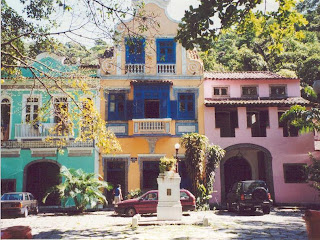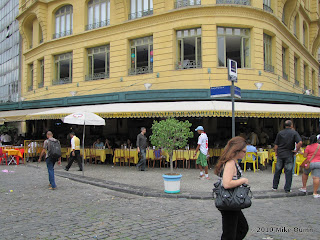Here ya go:
*****
The Real Bologna
 |
| Biba Caggiano |
But the relentless Biba pulled together her memories of the amazing cuisine she grew up with, and has since then assembled an empire worthy of any Caesar—but we’re not talking salads here. With the sixth in her series of authoritative cookbooks behind her (Biba’s Taste of Italy, William Morrow, 2001), Biba Caggiano’s domain also includes thousands of hands-on cooking classes, countless episodes of television instruction including two years on the Learning Channel, and the showcase for her crusade: Sacramento’s Biba, one of the finest Northern Italian restaurants outside of Italy.
 |
| Biba's Taste of Italy, 2001 |
“We’re talking 1969,” recalls Biba, “if I wanted to eat the foods I grew up with, I had to learn to duplicate what my mother used to do. What led me to the food I am known for today was my palate and my eye. When I looked into that pot, I could tell if it was almost right or not, too liquid, too light, too whatever. But it was my tastebuds that really guided me. For the first 23 years of my life I learned how the food should taste.”
And Biba was lucky enough to grow up in Bologna, the center of the region known as Emilia-Romagna, respected by most Italians as the ne plus ultra of a country already considered by the world as a food paradise. Imagine the flavors that trained her palate (and which constitute the focus of her new book as well): Emilia-Romagna is the home of Parmigiano-Reggiano, the most majestic of all cheeses; prosciutto di Parma, the most heavenly preparation of a pig’s hind leg imaginable; balsamic vinegar, the much abused curative and syrupy magic condiment; paper thin handmade pastas, filled and unfilled, regarded as Italy’s finest; ragù bolognese, which, when done properly, transcends any notion most of us have of what a pasta sauce can be; and of course mortadella, the true bologna, a melt-in-your-mouth treat that will permanantly erase all thoughts of Oscar Meyer you might be harboring.
“When you are young growing up, if you are lucky enough to live in a place like Bologna, you really don’t understand how lucky you are until you find yourself out of your homeland. That’s when your find out how different the world can be. When I first arrived in this country we were living in Queens with my husband’s parents, we were so broke. I went out one day to buy some bread and saw women on the street with rollers in their hair and slippers on their feet and there I was with my heels, my stockings, my good outfit, as we do in Italy when we go out. I looked at these women and thought, ‘Wow!’ And that’s when it hit me. I was really in a different place, I became really homesick for everything I left behind,” Biba remembers.
And the food memories?
“The first thing I wanted was the aroma of that broth on Sunday mornings when we kids would sleep in and my mother would get up early to put on the pot with all those bones and mixed meats; that is what used to wake us up,” says Caggiano. “The aroma was fabulous, and she would make these tiny tortellini which my brother and sister and I would help seal, or she would roll out a very thin delicate pasta, tagliolini, to go into the broth.
“We were raised in that kitchen, that nice large kitchen which was the center of our home, it’s where we did our homework. I stirred the sauces, I tasted, I would do things to help my mother. All these things came back to me, and as I thought about them, I gained a new appreciation of how wonderful it was to have had all those things. Lots of phone calls from Sacramento to my mother in Italy helped me remember all the correct ingredients, but, like I said, my palate and my memory guided me.”
In no time, her reputation as a cook spread through the capital city and she began giving cooking lessons in her home, eventually growing into the facilities of William Glen, a major source for things culinary in Sacramento. She started out with what she knew, the recipes from her hometown of Bologna, but eventually expanded her course to include other parts of her region as well.
But to Biba, one dish shines as the most exemplary of Bologna, and it is the dish that launched her career as a messenger of Bologna’s riches: lasagne alla bolognese.
| Lasagne alla Bolognese |
“I remember the first time I served lasagne to friends at one of our dinner parties. I saw people eating and they would stop and look at each other and I thought, ‘Gee! What did I do?’ So I asked, ‘Is anything wrong?’ They said, ‘No! This is wonderful! Why is it so delicate?’ Because you know, this was the time when the only lasagne they new were those thick packaged noodles, that’s what was in the stores. They had never had the real thing from Bologna. I was so pleased that the lasagne delighted them so.”
She adds, “It’s the classic, it’s so good. It’s not the type of food you eat every day, it is so rich, but when you eat it slowly, savoring every bite, and it goes down slowly, you know you are eating something special.
“It is one of those rare dishes that is perfect, but you have to do it right. You have to have the pasta that is transparent, you have to have the bechamel that is creamy, you have to have the meat sauce that is simmered slowly so you have just the meat essence.”
Dear reader, please notice there is no heavy ricotta, mozzarella, or sausage.
She will not stand for anyone trying to mess with such a perfect formula. “Years ago I had a friend in catering who wanted to serve my lasagne recipe. But he said it was not complicated enough for his clients. He said, ‘It’s kind of simple, can I jazz it up? Can I put some mushrooms in the meat sauce?’ I said, ‘WHAT?! You do not understand a damn thing! DON'T TOUCH THE DISH! It has stood the test of time over centuries. No, you may not alter the recipe.’ ”
Her devotion to her roots is evident in her Sacramento restaurant where I was lucky enough to have had lunch recently. I was transported back to Italy in a way no other Bay Area eatery has been able to do for me. The food was achiote- and kiwi-free, but instead, redolent of the purity of the simple, spare, and elegant ingredients found in each dish. Italian food ain’t necessarily some spicy meatball.
The spring-inspired menu I sampled offered a light pasta punctuated with prosciutto, asparagus tips, and fresh peas, all bound and contrasted with a slightly sharp, yet smooth parmigiano cream sauce. A lamb loin was simply grilled and framed with asparagus—no chef-ego-boosting lemongrass-crème frîeche sauce to weigh it down. And the torta di noci was the perfect, not-too-sweet walnut cake. Readers take note: this is a place you don’t want to miss, and is no farther than many of the trendoid joints up in Napa, of which Biba, not surprisingly, has a view (which I wholeheartedly share):
“These cooks are one of my pet peeves. There are several in Napa that are always being touted in magazines as serving wonderful Italian, let’s call what they do California-Italian, then I can understand that. But the thing is, if you do a dish, and you call it, let’s say, spaghetti carbonara, okay, then do that dish. We all know what goes into that dish: the eggs, the parmigiano, some put in a touch of cream, some don’t, pepper, and of course pancetta. I ordered that dish in one of these places, supposedly so great, and it came with how many other ingredients on top I don’t know. There were peas, tiny carrots. Okay, it was spring, the guy wants to put something seasonal on the menu, I have no problem with that. But don’t call it with that name, spaghetti carbonara, because it’s really a misrepresentation if you call a dish with a certain name that is classically made a certain way. If you have eaten it in Italy, that’s what you think it is; but people here change recipes all the time, they think they can improvise on them, but these recipes have been around for generations.”
 |
| Biba's Northern Italian Cooking |
These are the standards, then, that you can expect when you pick up one of Biba’s books. You will get the real deal, nothing more, nothing less. Her first book, Northern Italian Cooking, was an offshoot of her early classes in Sacramento. Around 1981, after five years of teaching, she had amassed enough material for a book and wanted to do one about the cuisine of Bologna. “The publisher said, ‘Uhh, Bo-? Bo-bo what?’ I said, ‘Bologna.’ They said, ‘Where’s that?’ I explained it to them and they said people will never be able to pronounce it, they will never know where it is, they will never be able to pronounce it. ‘Do a book on Northern Italian cooking,’ they said. This was a time when people thought Northern Italian meant just cream sauces and Southern meant red sauces. That book is still out there and has been selling well forever.” It has helped define the cooking of Northern Italy for more than 400,000 book buyers. Quite a feat for a cookbook.
Twenty years later she has finally published the book she could only dream about in the beginning. Biba’s Taste of Italy paints a delectable portrait of the most edible region of Italy. The book compiles recipes gathered from small trattorie, restaurants, at the market, from friends, family, all over years of travel back home, though it took her two and a half years to do the specific research for this volume, discovering along the way the essence of her native cuisine. “I know my region pretty well, she says, “but it was only when the book came together that I realized the dominance of Bologna as the center of the region—luckily, that’s where my gustatory gift came to life. It was nice doing this work, it was a good thing.
“I talked to anybody who seemed to know about food,” Biba explains, “I remember we were at the market one day selecting beautiful fresh fennel and there was a beautiful, elderly woman dressed so well picking up the fennel and I asked her, ‘How are you going to cook it when you get home?’ And she said, ‘I don’t know. I’ll figure it out when I get home.’ And that is really the essence of Italian cooking. Go to the market, get what is fresh and in season, take it home and then figure out how to cook it.”
Biba, who admits to having a weakness for potato chips and honey-roasted peanuts, sums up her career in a philosophical manner: “I am a mother. [Her own daughters have not strayed far—Carla, a new mother herself, lives blocks from Biba and her husband Vincent, and Paola, an avid cook herself, is a lawyer in Oakland.] I think I have always been a mother, even when I was young. I like to nurture people, I like to take care of people. And as I began to work with food, I found great joy.
My daughters would come home from school with some friends in tow and they would go into the kitchen where I would always have something ready for them. I was taking over what my mother had done without knowing it. That time around the table with family and friends is still one of the best things you find in Italy. It’s a wonderful cultural thing; so this is what I do now, it’s what I’ve been doing all my life.”
Biba Caggiano has educated thousands, if not millions, in the way of the one-true lasagne. Through her books, her television exposure and her admittedly Big Night-like travails leading her restaurant patrons to an authentic Italian trough, she has labored long and hard to maintain the memory of the food and techniques she learned at her mother’s side, that her mother learned from her mother and her mother from her mother. That’s the way it used to be. Might still be in some places. But if not, at least we can adopt Biba as our foster mom to show us around the kitchens of Bologna so we might start our own traditions in the shadow of Sacramento.
Sidebar:
Biba’s Domain
Books:
Northern Italian Cooking, HP Books, 1981—A quick survey of the classic foods found north of Rome. Lots of photos and illustrations make this an ideal book for beginners.
Modern Italian Cooking, Fireside, 1992. This is a reprint of her second book. Just what it says—she takes a slightly modern approach to tradition and lightens things up a bit and includes a slew of pasta dishes ready in 20 minutes or less.
Trattoria Cooking, Macmillan Publishing Company, 1992. A fantastic survey of simple recipes found in some of Italy’s most charming eating establishments. I love this book.
From Biba’s Italian Kitchen, William Morrow, 1995. This was published to accompany her program on the Learning Channel and concentrates, naturally, on recipes from the north. Another good starting point.
Italy Al Dente, William Morrow, 1998. This is a close-up look at first course items: pasta, risotto, gnocchi, polenta and soups collected primarily in the north, but includes some great stuff from Naples and Sicily.
Biba’s Taste of Italy, William Morrow, 2001. A fantastic, detailed survey of Emilia-Romagna, with special emphasis on Bologna and surrounding areas. If you can’t make it to Italy in person, this book will take you there.
Restaurant:
 |
| Biba's, Sacramento |
Mike Quinn, associate editor of The Monthly, has traveled to Italy 12 times since 1992 to research food, eat, drink and be merry. His attempt to buy a restaurant in Montalcino near Siena was thwarted by a stack of liens against the place, taller than the tower of Pisa.























